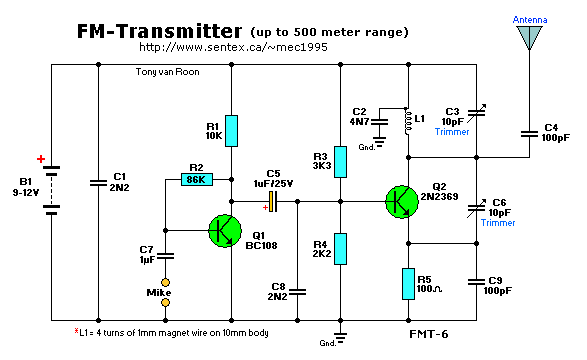
FM Transmitter, #6, up to 1/2 mile range
Parts List:
Resistors are 1/4 Watt, 5%
R1 = 10K
R2 = 86K
R3 = 3K3 (3.3K)
R4 = 2K2
R5 = 100 ohm
Capacitors:
C1,C8 = 2N2 (2.2nF), ceramic
C2 = 4N7, ceramic
C3,C6 = 10pF miniature variable
C4,C9 = 100pF, ceramic
C5 = 1uF, 25V, electrolytic
C7 = 1uF, polyester
Semiconductors:
Q1 = BC108, NTE123A, NPN transistor
Q2 = 2N2369, 2N2222, NTE123A, NPN transistor
L1 = 1mm enamelled copper wire on a 10mm body (no value specified)
Notes:
Q1 and Q2 both reference to a NTE123A replacement type.
With a short antenna the maximum distance is about 600 feet (200M). But with a proper antenna this distance can easily
be changed to about 1/2 mile (800M)! Even so, keep in mind that this simple transmitter is just that; simple!
If you find that the frequency drift a little, secure the coil with candle wax or a dab of hot-melt glue.
Coil L1 is wound on a 10mm body. Use a wooden dowel or similar. Wind about 4 turns of 1mm enameled copper wire
(also called 'magnet wire') on a 10mm body. Obviously, remove the body after winding.
Scrape the enamel off both ends of the coil before attempting to solder.
As for the ceramic capacitors, try to find and use the socalled 'NP0' types for low noise/temperature drift. They
have a black stripe at the top of the cap. They are manufactured by Philips.
The variable capacitors, C3 and C6, are just the regular trimmer caps.
This type of transmitter works best in a metal enclosure. Just make sure nothing of your circuit is touching it.
"Gnd." in the schematic diagram just refers to the negative pole of your battery.
Copyright and Credits:
Source: "Elektuur Magazine", 1992.
Document updates and modifications, all diagrams, Layout, editing, ©
Copyright by Tony van Roon.
Re-posting or taking graphics in any way or form of this project is expressly prohibited by international copyright
laws.
Back to Circuits page
Copyright © 1995 -- Tony van Roon
Last updated November 17, 2009

